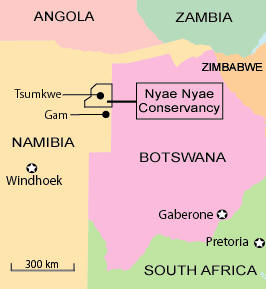Last Thursday, the Marine Stewardship Council announced that the rock lobster fishery operation of Tristan da Cunha has been certified as sustainable and well-managed. During a ceremony in the Shoreline Café, at Cape Town’s popular Two Oceans Aquarium, the MSC gave its award to the Ovenstone Agency, the local firm that manages the Tristan fishery.
 At the same ceremony, the MSC also recognized the café itself for its commitment to ascertaining that all the fish it serves is traceable to certified fisheries operations. It is the first restaurant in Africa to be so recognized, with the right to use the blue MSC certified label in its messages.
At the same ceremony, the MSC also recognized the café itself for its commitment to ascertaining that all the fish it serves is traceable to certified fisheries operations. It is the first restaurant in Africa to be so recognized, with the right to use the blue MSC certified label in its messages.
Martin Purves, Southern Africa Programme Manager for MSC, hailed both the Tristan fishery operation and the popular restaurant for their commitments to sustainable fishing practices.
The Ovenstone Agencies is the sole holder of a concession with rights to operate the lobster fishery in the waters of Tristan da Cunha and its neighboring islands. Islanders employed by the company conduct the fishing operations from dories in the inshore waters of the islands. Islanders also work in the processing factory on Tristan. The M.V. Edinburgh, the freezer factory ship operated by Ovenstone, also provides passenger and freight transportation service to and from Cape Town.
The Ovenstone fishery started investigating MSC certification early in 2010, and has had to satisfy a rigorous investigation over the intervening months. The company had to demonstrate that the fishery does not over-harvest the resource, that it is effectively managed, and that it maintains, in the words of the MSC news release, “the health and productivity of the wider marine ecosystem.”
James Glass, the Tristan Director of Fisheries, explained how important the new certification would be to the island economy. He said that the “careful management of the lobster fishery is the foundation of the continued economic independence of the Tristan community.” He expressed the hope that the MSC certification would help them find new markets. The MSC ecolabel should help Tristan lobsters compete with comparable fisheries products on world markets.
Dr. Andrew James, Managing Director of Ovenstone Agencies expressed his delight that his company’s careful stewardship of the natural environment has been recognized by the MSC. The annual harvest of rock lobsters, about 440 tons of crustaceans, is sold primarily to high end restaurants in the United States, and to Japan for bento boxes.





 Cwisa Cwi, principal of the Nyae Nyae school system, told the newspaper that Ju/’hoansi parents support the schools in principle but they expect the teachers to handle all disciplinary matters themselves. He said that parents often do not insist that their children attend school, so there is a high drop out rate. He also complained that many parents do not become involved with school activities such as the school feeding programs or story-telling activities.
Cwisa Cwi, principal of the Nyae Nyae school system, told the newspaper that Ju/’hoansi parents support the schools in principle but they expect the teachers to handle all disciplinary matters themselves. He said that parents often do not insist that their children attend school, so there is a high drop out rate. He also complained that many parents do not become involved with school activities such as the school feeding programs or story-telling activities.


